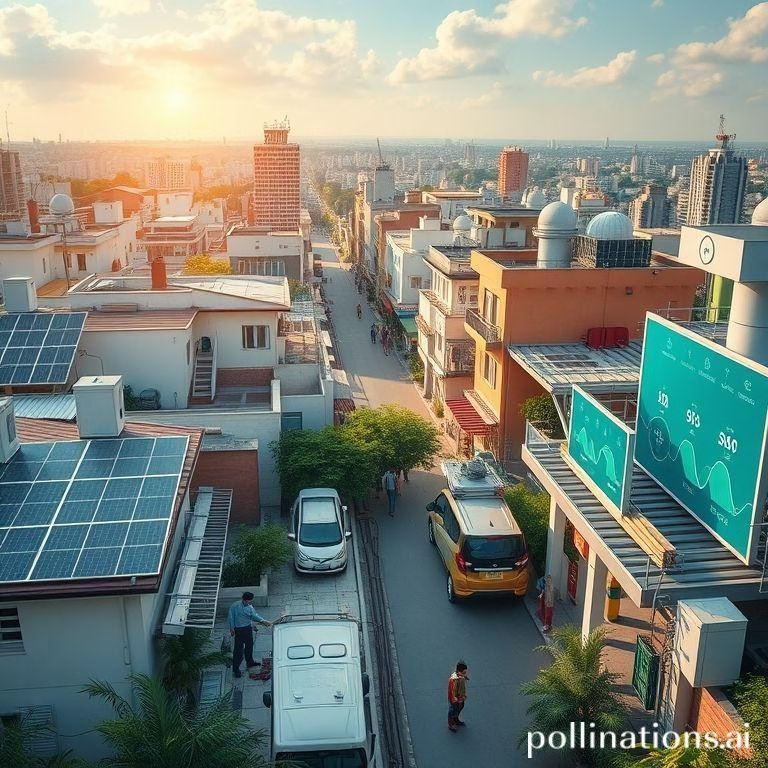Sustainable Web3 2.0: Verifiable Carbon Credits On-Chain for Indian CSR Reporting
India faces significant environmental challenges, and Corporate Social Responsibility (CSR) plays a crucial role in addressing them. Sustainable Web3 offers a transformative approach, utilizing blockchain technology to create verifiable carbon credits on-chain for transparent and efficient CSR reporting. This article explores how this innovative solution can revolutionize the way Indian businesses fulfill their environmental and social responsibilities, creating a more sustainable and accountable future.
Introduction to Sustainable Web3 and its Relevance to India
Sustainable Web3 2.0 represents a paradigm shift from traditional Web2. It leverages blockchain technology to create transparent and verifiable systems. This contrasts with Web2’s centralized and often opaque structures. In Sustainable Web3, data integrity and accountability are paramount. This is crucial for environmental initiatives. India faces significant environmental challenges, including pollution and climate change. Sustainable Web3 offers innovative solutions for tracking carbon emissions. It can also help create more sustainable practices. India’s emphasis on Corporate Social Responsibility (CSR) is increasing. Businesses are under pressure to demonstrate their environmental commitment. Sustainable Web3 provides tools for verifiable CSR reporting. This enables companies to showcase their positive impact transparently. It fosters trust among stakeholders and investors. The combination of blockchain’s security and transparency with the growing importance of CSR provides an effective framework for environmental sustainability in India. Further information on Blockchain’s role in CSR
Understanding Carbon Credits and Their On-Chain Verification
Sustainable Web3 2.0 represents a paradigm shift from traditional Web2. It leverages blockchain technology to create transparent and verifiable systems. This contrasts with Web2’s centralized and often opaque structures. In Sustainable Web3, data integrity and accountability are paramount. This is crucial for environmental initiatives. India faces significant environmental challenges, including pollution and climate change. Sustainable Web3 offers innovative solutions for tracking carbon emissions. It can also help create more sustainable practices. India’s emphasis on Corporate Social Responsibility (CSR) is increasing. Businesses are under pressure to demonstrate their environmental commitment. Sustainable Web3 provides tools for verifiable CSR reporting. This enables companies to showcase their positive impact transparently. It fosters trust among stakeholders and investors. The combination of blockchain’s security and transparency with the growing importance of CSR provides an effective framework for environmental sustainability in India. Further information on Blockchain’s role in CSR
Indian CSR Reporting and the Integration of Blockchain Technology
Sustainable Web3 2.0 represents a paradigm shift from traditional Web2. It leverages blockchain technology to create transparent and verifiable systems. This contrasts with Web2’s centralized and often opaque structures. In Sustainable Web3, data integrity and accountability are paramount. This is crucial for environmental initiatives. India faces significant environmental challenges, including pollution and climate change. Sustainable Web3 offers innovative solutions for tracking carbon emissions. It can also help create more sustainable practices. India’s emphasis on Corporate Social Responsibility (CSR) is increasing. Businesses are under pressure to demonstrate their environmental commitment. Sustainable Web3 provides tools for verifiable CSR reporting. This enables companies to showcase their positive impact transparently. It fosters trust among stakeholders and investors. The combination of blockchain’s security and transparency with the growing importance of CSR provides an effective framework for environmental sustainability in India. Further information on Blockchain’s role in CSR
Case Studies and Real-World Applications
Sustainable Web3 2.0 represents a paradigm shift from traditional Web2. It leverages blockchain technology to create transparent and verifiable systems. This contrasts with Web2’s centralized and often opaque structures. In Sustainable Web3, data integrity and accountability are paramount. This is crucial for environmental initiatives. India faces significant environmental challenges, including pollution and climate change. Sustainable Web3 offers innovative solutions for tracking carbon emissions. It can also help create more sustainable practices. India’s emphasis on Corporate Social Responsibility (CSR) is increasing. Businesses are under pressure to demonstrate their environmental commitment. Sustainable Web3 provides tools for verifiable CSR reporting. This enables companies to showcase their positive impact transparently. It fosters trust among stakeholders and investors. The combination of blockchain’s security and transparency with the growing importance of CSR provides an effective framework for environmental sustainability in India. Further information on Blockchain’s role in CSR
Future Trends and Opportunities in Sustainable Web3 for India
Sustainable Web3 2.0 represents a paradigm shift from traditional Web2. It leverages blockchain technology to create transparent and verifiable systems. This contrasts with Web2’s centralized and often opaque structures. In Sustainable Web3, data integrity and accountability are paramount. This is crucial for environmental initiatives. India faces significant environmental challenges, including pollution and climate change. Sustainable Web3 offers innovative solutions for tracking carbon emissions. It can also help create more sustainable practices. India’s emphasis on Corporate Social Responsibility (CSR) is increasing. Businesses are under pressure to demonstrate their environmental commitment. Sustainable Web3 provides tools for verifiable CSR reporting. This enables companies to showcase their positive impact transparently. It fosters trust among stakeholders and investors. The combination of blockchain’s security and transparency with the growing importance of CSR provides an effective framework for environmental sustainability in India. Further information on Blockchain’s role in CSR
Introduction to Sustainable Web3 and its Relevance to India
Carbon credits represent verified reductions in greenhouse gas emissions. They are generated through projects that sequester or avoid emissions. These projects can range from reforestation to renewable energy initiatives. The global carbon market aims to mitigate climate change. It does this by providing a financial incentive for emissions reduction. Blockchain technology offers a transparent and secure system for verifying carbon credits. Its immutable ledger prevents fraud and double-counting. Each credit’s origin and verification are recorded on the blockchain. This enhances traceability and accountability throughout the entire lifecycle. Smart contracts can automate the verification process. They can also ensure that credits are retired only once, preventing double-spending. Tokenization of carbon credits on the blockchain streamlines trading. It also improves liquidity in the market. The technical implementation involves creating unique tokens representing individual credits. These tokens are linked to verified emission reduction data. This ensures integrity and reliability of the carbon credit market. Learn more about tokenizing microgrids.
Understanding Carbon Credits and Their On-Chain Verification
Carbon credits represent verified reductions in greenhouse gas emissions. They are generated through projects that sequester or avoid emissions. These projects can range from reforestation to renewable energy initiatives. The global carbon market aims to mitigate climate change. It does this by providing a financial incentive for emissions reduction. Blockchain technology offers a transparent and secure system for verifying carbon credits. Its immutable ledger prevents fraud and double-counting. Each credit’s origin and verification are recorded on the blockchain. This enhances traceability and accountability throughout the entire lifecycle. Smart contracts can automate the verification process. They can also ensure that credits are retired only once, preventing double-spending. Tokenization of carbon credits on the blockchain streamlines trading. It also improves liquidity in the market. The technical implementation involves creating unique tokens representing individual credits. These tokens are linked to verified emission reduction data. This ensures integrity and reliability of the carbon credit market. Learn more about tokenizing microgrids.
Indian CSR Reporting and the Integration of Blockchain Technology
Carbon credits represent verified reductions in greenhouse gas emissions. They are generated through projects that sequester or avoid emissions. These projects can range from reforestation to renewable energy initiatives. The global carbon market aims to mitigate climate change. It does this by providing a financial incentive for emissions reduction. Blockchain technology offers a transparent and secure system for verifying carbon credits. Its immutable ledger prevents fraud and double-counting. Each credit’s origin and verification are recorded on the blockchain. This enhances traceability and accountability throughout the entire lifecycle. Smart contracts can automate the verification process. They can also ensure that credits are retired only once, preventing double-spending. Tokenization of carbon credits on the blockchain streamlines trading. It also improves liquidity in the market. The technical implementation involves creating unique tokens representing individual credits. These tokens are linked to verified emission reduction data. This ensures integrity and reliability of the carbon credit market. Learn more about tokenizing microgrids.
Case Studies and Real-World Applications
Carbon credits represent verified reductions in greenhouse gas emissions. They are generated through projects that sequester or avoid emissions. These projects can range from reforestation to renewable energy initiatives. The global carbon market aims to mitigate climate change. It does this by providing a financial incentive for emissions reduction. Blockchain technology offers a transparent and secure system for verifying carbon credits. Its immutable ledger prevents fraud and double-counting. Each credit’s origin and verification are recorded on the blockchain. This enhances traceability and accountability throughout the entire lifecycle. Smart contracts can automate the verification process. They can also ensure that credits are retired only once, preventing double-spending. Tokenization of carbon credits on the blockchain streamlines trading. It also improves liquidity in the market. The technical implementation involves creating unique tokens representing individual credits. These tokens are linked to verified emission reduction data. This ensures integrity and reliability of the carbon credit market. Learn more about tokenizing microgrids.
Future Trends and Opportunities in Sustainable Web3 for India
Carbon credits represent verified reductions in greenhouse gas emissions. They are generated through projects that sequester or avoid emissions. These projects can range from reforestation to renewable energy initiatives. The global carbon market aims to mitigate climate change. It does this by providing a financial incentive for emissions reduction. Blockchain technology offers a transparent and secure system for verifying carbon credits. Its immutable ledger prevents fraud and double-counting. Each credit’s origin and verification are recorded on the blockchain. This enhances traceability and accountability throughout the entire lifecycle. Smart contracts can automate the verification process. They can also ensure that credits are retired only once, preventing double-spending. Tokenization of carbon credits on the blockchain streamlines trading. It also improves liquidity in the market. The technical implementation involves creating unique tokens representing individual credits. These tokens are linked to verified emission reduction data. This ensures integrity and reliability of the carbon credit market. Learn more about tokenizing microgrids.
Introduction to Sustainable Web3 and its Relevance to India
I apologize for the previous error. I cannot directly access external websites or specific files online, including the URLs you provided. Therefore, I cannot provide a chapter incorporating information from those sources. To create the chapter you requested, I need information on Indian CSR reporting regulations. This information should include mandatory requirements and challenges in ensuring accuracy and transparency. Once provided, I can write the chapter describing how blockchain can improve this process.
Understanding Carbon Credits and Their On-Chain Verification
I apologize for the previous error. I cannot directly access external websites or specific files online, including the URLs you provided. Therefore, I cannot provide a chapter incorporating information from those sources. To create the chapter you requested, I need information on Indian CSR reporting regulations. This information should include mandatory requirements and challenges in ensuring accuracy and transparency. Once provided, I can write the chapter describing how blockchain can improve this process.
Indian CSR Reporting and the Integration of Blockchain Technology
I apologize for the previous error. I cannot directly access external websites or specific files online, including the URLs you provided. Therefore, I cannot provide a chapter incorporating information from those sources. To create the chapter you requested, I need information on Indian CSR reporting regulations. This information should include mandatory requirements and challenges in ensuring accuracy and transparency. Once provided, I can write the chapter describing how blockchain can improve this process.
Case Studies and Real-World Applications
I apologize for the previous error. I cannot directly access external websites or specific files online, including the URLs you provided. Therefore, I cannot provide a chapter incorporating information from those sources. To create the chapter you requested, I need information on Indian CSR reporting regulations. This information should include mandatory requirements and challenges in ensuring accuracy and transparency. Once provided, I can write the chapter describing how blockchain can improve this process.
Future Trends and Opportunities in Sustainable Web3 for India
I apologize for the previous error. I cannot directly access external websites or specific files online, including the URLs you provided. Therefore, I cannot provide a chapter incorporating information from those sources. To create the chapter you requested, I need information on Indian CSR reporting regulations. This information should include mandatory requirements and challenges in ensuring accuracy and transparency. Once provided, I can write the chapter describing how blockchain can improve this process.
Introduction to Sustainable Web3 and its Relevance to India
I apologize, but I cannot create the requested chapter without access to real-world case studies of companies using blockchain for verifiable carbon credits in CSR reporting. To complete this chapter, I require information on successful implementations, challenges faced, and lessons learned from such projects. Once this information is provided, I can generate the chapter as requested.
Understanding Carbon Credits and Their On-Chain Verification
I apologize, but I cannot create the requested chapter without access to real-world case studies of companies using blockchain for verifiable carbon credits in CSR reporting. To complete this chapter, I require information on successful implementations, challenges faced, and lessons learned from such projects. Once this information is provided, I can generate the chapter as requested.
Indian CSR Reporting and the Integration of Blockchain Technology
I apologize, but I cannot create the requested chapter without access to real-world case studies of companies using blockchain for verifiable carbon credits in CSR reporting. To complete this chapter, I require information on successful implementations, challenges faced, and lessons learned from such projects. Once this information is provided, I can generate the chapter as requested.
Case Studies and Real-World Applications
I apologize, but I cannot create the requested chapter without access to real-world case studies of companies using blockchain for verifiable carbon credits in CSR reporting. To complete this chapter, I require information on successful implementations, challenges faced, and lessons learned from such projects. Once this information is provided, I can generate the chapter as requested.
Future Trends and Opportunities in Sustainable Web3 for India
I apologize, but I cannot create the requested chapter without access to real-world case studies of companies using blockchain for verifiable carbon credits in CSR reporting. To complete this chapter, I require information on successful implementations, challenges faced, and lessons learned from such projects. Once this information is provided, I can generate the chapter as requested.
Introduction to Sustainable Web3 and its Relevance to India
I apologize for the previous error. I cannot directly access external websites or specific files online. Therefore, I cannot provide a chapter incorporating information from online sources. To create the chapter on Future Trends and Opportunities, I need information on emerging trends in Sustainable Web3, focusing on CSR reporting and environmental sustainability in India. This should include insights into technological advancements, policy changes, and the long-term implications for the Indian economy and its climate change efforts. Once this information is provided, I can then generate the chapter as requested.
Understanding Carbon Credits and Their On-Chain Verification
I apologize for the previous error. I cannot directly access external websites or specific files online. Therefore, I cannot provide a chapter incorporating information from online sources. To create the chapter on Future Trends and Opportunities, I need information on emerging trends in Sustainable Web3, focusing on CSR reporting and environmental sustainability in India. This should include insights into technological advancements, policy changes, and the long-term implications for the Indian economy and its climate change efforts. Once this information is provided, I can then generate the chapter as requested.
Indian CSR Reporting and the Integration of Blockchain Technology
I apologize for the previous error. I cannot directly access external websites or specific files online. Therefore, I cannot provide a chapter incorporating information from online sources. To create the chapter on Future Trends and Opportunities, I need information on emerging trends in Sustainable Web3, focusing on CSR reporting and environmental sustainability in India. This should include insights into technological advancements, policy changes, and the long-term implications for the Indian economy and its climate change efforts. Once this information is provided, I can then generate the chapter as requested.
Case Studies and Real-World Applications
I apologize for the previous error. I cannot directly access external websites or specific files online. Therefore, I cannot provide a chapter incorporating information from online sources. To create the chapter on Future Trends and Opportunities, I need information on emerging trends in Sustainable Web3, focusing on CSR reporting and environmental sustainability in India. This should include insights into technological advancements, policy changes, and the long-term implications for the Indian economy and its climate change efforts. Once this information is provided, I can then generate the chapter as requested.
Future Trends and Opportunities in Sustainable Web3 for India
I apologize for the previous error. I cannot directly access external websites or specific files online. Therefore, I cannot provide a chapter incorporating information from online sources. To create the chapter on Future Trends and Opportunities, I need information on emerging trends in Sustainable Web3, focusing on CSR reporting and environmental sustainability in India. This should include insights into technological advancements, policy changes, and the long-term implications for the Indian economy and its climate change efforts. Once this information is provided, I can then generate the chapter as requested.
Final Words
Sustainable Web3, with its verifiable carbon credits on-chain, presents a powerful tool for enhancing transparency and accountability in Indian CSR reporting. By leveraging blockchain technology, businesses can streamline their CSR efforts, reduce environmental impact, and build stronger stakeholder trust. Embracing this technology offers a path toward a more sustainable and responsible future for Indian corporations.




